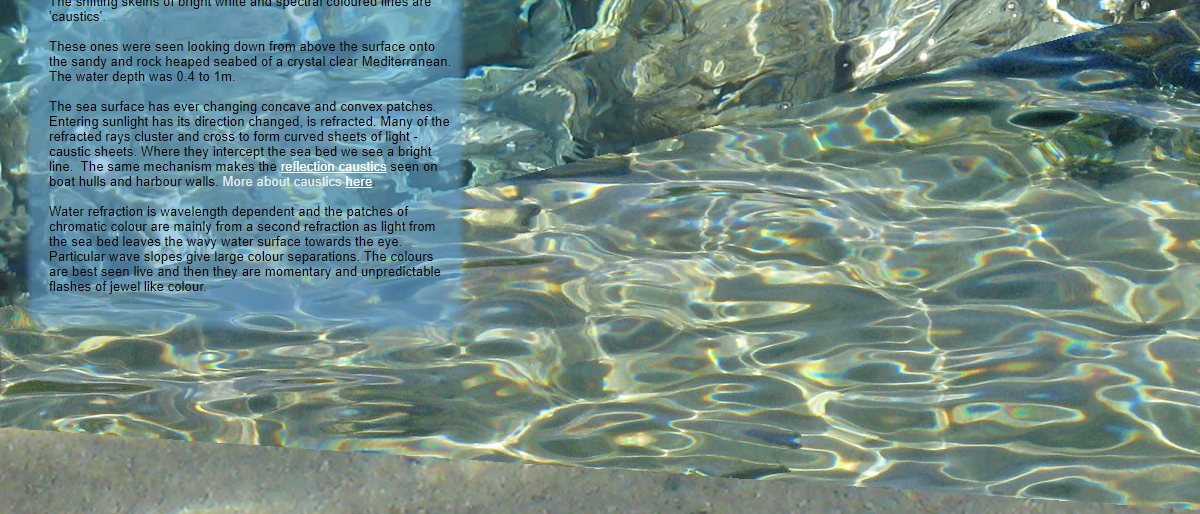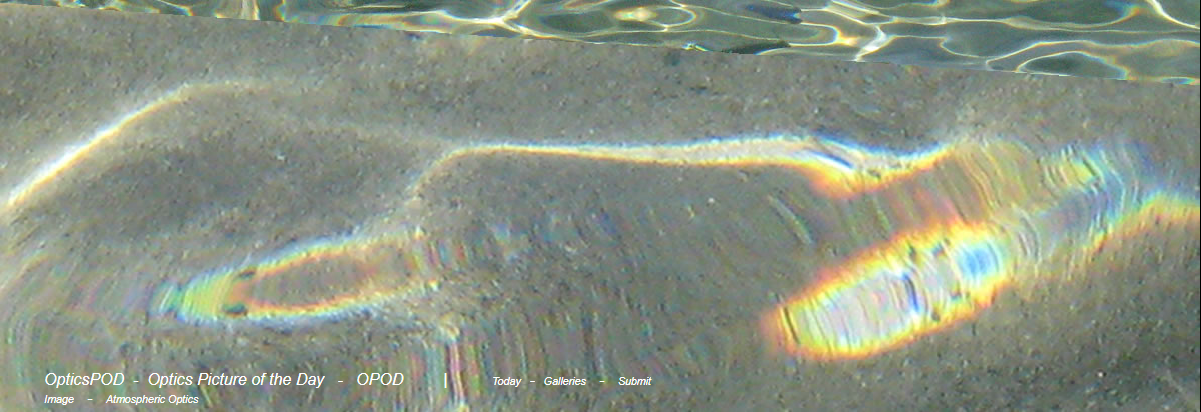Refraction Caustics
Refraction Caustics: A Phenomenon of Shifting Light
Refraction caustics are a mesmerizing atmospheric optics phenomenon that occurs when sunlight passes through the ever-changing surface of water. These captivating displays of bright white and spectral colored lines, known as caustics, can be observed when looking down from above the surface onto the sandy and rock heaped seabed of a crystal clear body of water.
The caustics are created by the interaction between the entering sunlight and the varying concave and convex patches on the sea surface. As the sunlight is refracted, many of the rays cluster and cross, forming curved sheets of light that intersect with the seabed, resulting in the appearance of bright lines. This same mechanism is responsible for the reflection caustics seen on boat hulls and harbour walls, adding to the allure of these optical phenomena.
The phenomenon of refraction caustics is not limited to its visual appeal; it also provides valuable insights into the behavior of light as it interacts with water. Water refraction is wavelength dependent, meaning that different colors of light are bent at different angles as they pass through the water. This leads to the patches of chromatic color observed in refraction caustics. Interestingly, these colors are primarily caused by a second refraction as light from the sea bed leaves the wavy water surface towards the observer.
The intensity and separation of colors within refraction caustics can vary depending on the slope of the waves on the water's surface. Certain wave slopes can produce large color separations, resulting in vivid displays of jewel-like flashes of color. To fully appreciate the beauty and transience of these colors, observing them firsthand is recommended, as they are momentary and unpredictable.
Refraction caustics are not only a captivating natural phenomenon but also a subject of scientific study. Researchers have delved into understanding the intricacies of light refraction and the formation of caustics, providing valuable insights into the behavior of light in various environments. By studying these phenomena, scientists can gain a deeper understanding of the properties of light and its interaction with different mediums.
In conclusion, refraction caustics are a breathtaking display of shifting light that occurs when sunlight passes through the ever-changing surface of water. These mesmerizing patterns of bright white and spectral colored lines offer a glimpse into the fascinating behavior of light as it interacts with its environment. Whether observed from above the surface or reflected on boat hulls and harbour walls, refraction caustics are a reminder of the enchanting wonders that can be found in the natural world.

Refraction Caustics. Image by Les Cowley June '09.
The shifting skeins of bright white and spectral coloured lines are 'caustics'.
These ones were seen looking down from above the surface onto the sandy and rock heaped seabed of a crystal clear Mediterranean. The water depth was 0.4 to 1m.
The sea surface has ever changing concave and convex patches. Entering sunlight has its direction changed, is refracted. Many of the refracted rays cluster and cross to form curved sheets of light - caustic sheets. Where they intercept the sea bed we see a bright line. The same mechanism makes the reflection caustics seen on boat hulls and harbour walls. More about caustics here.

Water refraction is wavelength dependent and the patches of chromatic colour are mainly from a second refraction as light from the sea bed leaves the wavy water surface towards the eye. Particular wave slopes give large colour separations. The colours are best seen live and then they are momentary and unpredictable flashes of jewel like colour.

Note: this article has been automatically converted from the old site and may not appear as intended. You can find the original article here.
Reference Atmospheric Optics
If you use any of the definitions, information, or data presented on Atmospheric Optics, please copy the link or reference below to properly credit us as the reference source. Thank you!
-
<a href="https://atoptics.co.uk/blog/refraction-caustics/">Refraction Caustics</a>
-
"Refraction Caustics". Atmospheric Optics. Accessed on December 26, 2024. https://atoptics.co.uk/blog/refraction-caustics/.
-
"Refraction Caustics". Atmospheric Optics, https://atoptics.co.uk/blog/refraction-caustics/. Accessed 26 December, 2024
-
Refraction Caustics. Atmospheric Optics. Retrieved from https://atoptics.co.uk/blog/refraction-caustics/.